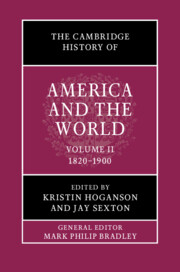Book contents
- The Cambridge History of America and the World
- The Cambridge History of America and the World
- The Cambridge History of America and the World
- Copyright page
- Contents
- Figures
- Maps
- Tables
- Contributors to Volume II
- General Introduction: What is America and the World?
- Introduction to Volume II
- Part I Building and Resisting US Empire
- Part II Imperial Structures
- Part III Americans and the World
- Part IV Americans in the World
- 23 The Changing Geography of Mobility, 1820–1940
- 24 The United States and the Greater Caribbean, 1763–1898
- 25 Borderlands and Border Crossings
- 26 The Liberal North Atlantic
- 27 “To Enter America from Africa and Africa from America” during the Nineteenth Century
- 28 Islamic World Encounters
- 29 The American Island Empire: US Expansionism in the Pacific and the Caribbean
- 30 Inter-Imperial Entanglements in the Age of Imperial Globalization
- Index
25 - Borderlands and Border Crossings
from Part IV - Americans in the World
Published online by Cambridge University Press: 12 November 2021
- The Cambridge History of America and the World
- The Cambridge History of America and the World
- The Cambridge History of America and the World
- Copyright page
- Contents
- Figures
- Maps
- Tables
- Contributors to Volume II
- General Introduction: What is America and the World?
- Introduction to Volume II
- Part I Building and Resisting US Empire
- Part II Imperial Structures
- Part III Americans and the World
- Part IV Americans in the World
- 23 The Changing Geography of Mobility, 1820–1940
- 24 The United States and the Greater Caribbean, 1763–1898
- 25 Borderlands and Border Crossings
- 26 The Liberal North Atlantic
- 27 “To Enter America from Africa and Africa from America” during the Nineteenth Century
- 28 Islamic World Encounters
- 29 The American Island Empire: US Expansionism in the Pacific and the Caribbean
- 30 Inter-Imperial Entanglements in the Age of Imperial Globalization
- Index
Summary
It has become second nature to see US borderlands as spaces of demarcation – with fences, walls, and patrols to mark continental divides. This is, however, a relatively recent view. We might trace its roots to 1910, when troops began patrolling the line following the outbreak of the Mexican Revolution; or to 1911, when the United States began to string up fence to keep tick-infested cattle in Mexico. Only by the 1920s and 1930s – with immigration quotas, a newly minted US Border Patrol, efforts to stem Prohibition-era flows of alcohol, and the repatriation of Mexicans in the Great Depression – did state-managed gate-keeping and partition become, in the words of historian Rachel St. John, “the defining feature of spatial organization along the border.”
- Type
- Chapter
- Information
- The Cambridge History of America and the World , pp. 594 - 616Publisher: Cambridge University PressPrint publication year: 2022



